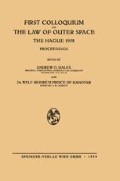Abstract
In view of everything which has been said and written about space law in the United States [1], Canada [2], Europe [3] and in other parts of the world, some points are now quite clear and, in theory, there is almost unanimous accord on the essential elements of the law of space.
Access this chapter
Tax calculation will be finalised at checkout
Purchases are for personal use only
Preview
Unable to display preview. Download preview PDF.
References
J. C. Cooper, High Altitude Flight and National Sovereignty. Internat. Law Quart. 4, 417 (1951).
J. C. Cooper, Legal Problems of Upper Space. Lecture before the American Society of International Law, April 25–26, 1956. Proc. Amer. Soc. Internat. Law 50, 91 (1956).
J. C. Cooper, Roman Law and the Maxim “Cuius est solum” in International Air Law. Publication No. 1 of the Institute of International Air Law, McGill University, Montreal, 1955.
A. G. Haley, Space Law—Basic Concepts. Tennessee Law Rev. 24, 643 (1956).
A. G. Haley, International Cooperation in Astronautics. Foreign Service J. 35, No. 4, 42 (1958).
A. G. Haley, Space Law and Metalaw—A Synoptic View. Harvard Univ. Law Rec. 23, No. 8 (1956).
C. W. Jenks, International Law and Activities in Space. Internat. Comp. Law Quart. 5, 99 (1956).
O. Schachter, Legal Aspects of Space Travel. J. Brit. Interplan. Soc. 11, 14 (1952).
E. Weinmann and H. C. Macdougall, The Law of Space. Foreign Service J. 35 (1958), April.
E. Pépin, The Legal Status of the Air Space in the Light of Progress in Aviation and Astronautics. Publication No. 2 of the Institute of International Air Law, McGill University, Montreal, 1957.
E. Pépin, Legal Problems Created by the Sputnik. Publication No. 4 of the Institute of International Air Law, McGill University, Montreal, 1958.
W. Mandl, Der Weltraum. Ein Problem der Raumfahrt Mannheim-BerlinLeipzig: Bensheimer, 1932.
A. Meyer, Rechtliche Probleme des Weltraumflugs (Legal Problems of Flight into the Outer Space). Z. Luftrecht 2, 37 (1953).
Meyer, Der künstliche Erdsatellit als Rechtsproblem. Neue Zürcher Ztg., October 22, 1957.
Meyer, Anmerkungen zu dem Vortrag, gehalten von J. C. COOPER am 26. April 1956 über die rechtlichen Probleme des Weltraums. Z. Luftrecht 5, 171 (1956).
Welf Heinrich Prince Of Hanover, Luftrecht und Weltraum (Air Law and Space), p. 72. Doctor Dissertation submitted to the Faculty of Law and Political Science at the George August University of Göttingen, 1953.
Cheng, Bin, International Law and High Altitude Flights: Balloons, Rockets and Man-Made Satellites. Internat. Comp. Law Quart. 3, 487 (1957).
K. H. Böhme, Lufthoheit und Weltraumflug. Z. Luftrecht 5, 184 (1956).
D. Goedhuis, The Limitation of Air Sovereignty. Conference of the International Law Association, Dubrovnik 1956.
Joeden, Äthersouveränität oder Ätherfreiheit. Jb. Internat. Recht 3, 85 (1954).
J. Kroell, Einem Weltraumrecht entgegen. Z. Luftrecht 1, 254 (1952).
Min-Ming-Peng, Le vol it haute altitude et l’article 1-er de la Convention de Chicago. Rev. Franç. Droit Aérien 6, 390 (1952).
W. Guldimann, Cuius est solum, eius est usque ad coelum. Z. Luftrecht 1, 213 (1952).
A. Meyer, op. cit. in Z. Luftrecht 5, 182 (1956).
J. C. Cooper, in the above mentioned lecture before the American Society of International Law, April 25–26, 1956, and A. Meyer, op. cit. p. 180, and others.
D.Goedhuis, op. cit.
See the different views about the problem of sovereignty in BÖhme, op. cit., and by Meyer and Cooper.
The system of three zones which was proposed by Professor Cooper for the outer space is only a continuation of the system of zones which Fauchille introduced in the early years of the 20th century for air space. P. Fauchille, Le domaine aérien et le régime juridique des aérostats. Paris: Dalloz, 1901.
Author information
Authors and Affiliations
Editor information
Editors and Affiliations
Rights and permissions
Copyright information
© 1959 Springer-Verlag Wien
About this paper
Cite this paper
Smirnoff, M. (1959). The Need for a New System of Norms for Space Law and the Danger of Conflict with the Terms of the Chicago Convention. In: Haley, A.G., Heinrich, W. (eds) First Colloquium on the Law of Outer Space. Springer, Vienna. https://doi.org/10.1007/978-3-7091-4414-5_23
Download citation
DOI: https://doi.org/10.1007/978-3-7091-4414-5_23
Publisher Name: Springer, Vienna
Print ISBN: 978-3-211-80509-1
Online ISBN: 978-3-7091-4414-5
eBook Packages: Springer Book Archive

